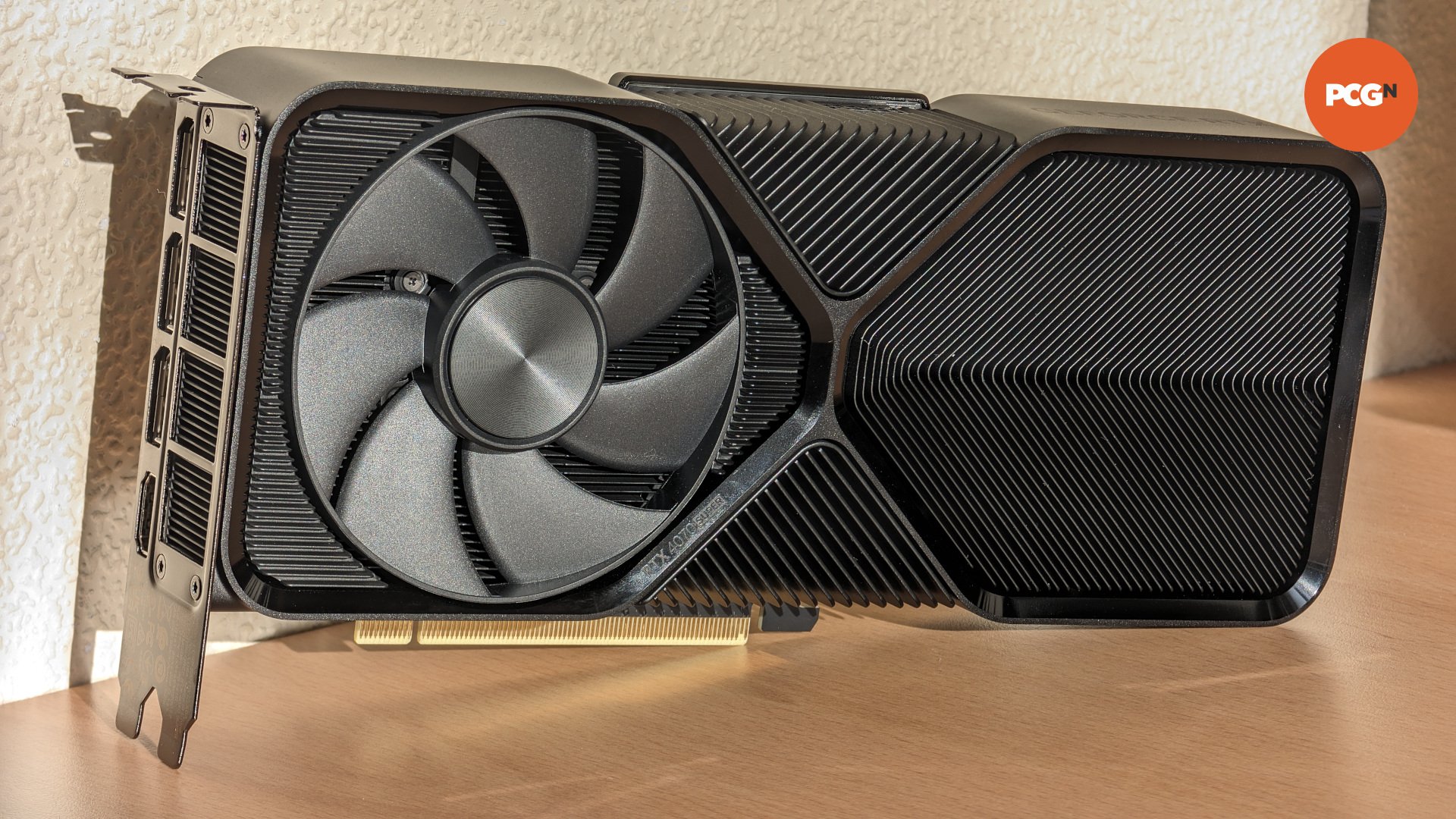Our Verdict
The GeForce RTX 4070 Super is a great graphics card for gaming at 1080p and 1440p, particularly for those who prefer to play with ray tracing enabled. Its rasterization and memory bandwidth shortfalls can be addressed through DLSS 3, but it can't quite cope with 4K gaming. If your budget can stretch to its $599 price tag, this is the mid-range GPU to buy.
- RTX 4070 Ti-like performance for $600
- Better value than RTX 4070
- DLSS 3 support
- Rasterization performance could be better
- Can't quite cope with 4K gaming
- Slightly higher power draw
The Nvidia GeForce RTX 4070 Super has arrived in a more well-rounded market than the original GeForce RTX 4070, with both cheaper competitors and siblings eating at its potential value. Despite this, Nvidia has been successful in crafting a graphics card that finds its niche and then some, even if it is not quite the marvelous midrange do-it-all model we wanted.
Why you can trust our advice ✔ At PCGamesN, our experts spend hours testing hardware and reviewing games and VPNs. We share honest, unbiased opinions to help you buy the best. Find out how we test.
We have been testing the Nvidia GeForce RTX 4070 Super for the past few weeks, putting it up against the best graphics card models in its price class in our newly refreshed benchmark suite. In that time, it has performed admirably and has left us generally impressed.
Nvidia GeForce RTX 4070 Super specs
Comparing the RTX 4070 Super specs to those of the standard RTX 4070, it is plain to see Nvidia has given its new graphics card a sizeable and welcome boost. The new Super pixel pusher packs 22% more CUDA, RT, and Tensor cores, making it closer in core count to the RTX 4070 Ti than its non-Super sibling.
| RTX 4070 Super | RTX 4070 | |
| GPU | AD104 | AD104 |
| CUDA Cores |
7,168 | 5,888 |
| RT Cores |
56 | 46 |
| Tensor Cores |
224 | 184 |
| Base clock |
1,980MHz (1.98GHz) | 1,920MHz (1.92GHz) |
| Boost clock | 2,475MHz (2.48GHz) | 2,475MHz (2.48GHz) |
| VRAM | 12GB GDDR6X | 12GB GDDR6X |
| Memory bus width | 192-bit | 192-bit |
| TGP | 220W | 200W |
| MSRP | $599 | $549 |
While its boost clock remains unchanged, the base clock has received a modest 60MHz increase. Similarly, the total graphics card power (TGP) has been bumped slightly from 200W to 220W, but this is still lower than that of the RTX 4070 Ti (285W).
VRAM capacity and bandwidth, sadly, remain the same at 12GB and 504GB/s, respectively. This is ultimately a consequence of the graphics card having a 192-bit memory bus, and moving to 16GB of memory with the Ada architecture would require a 256-bit bus. Nvidia could have fitted 24GB of VRAM to the RTX 4070 Super, but that would severely inflate the price.
As much as we understand the reasons behind this flaw, and believe Nvidia made the right choice to prioritize cost, we sincerely hope that a 50-series successor will not suffer from the same VRAM capacity issues. When all is said and done, however, the RTX 4070 Super specs generally make it the better-value buy compared to the RTX 4070 on paper, despite its higher price.
Nvidia GeForce RTX 4070 Super benchmarks
For our RTX 4070 Super benchmarks, we have captured frame rate data at native 1080p, 1440p, and 4K resolutions. We have split our findings into sections that each cover ray tracing and rasterization performance, as well as the impact of DLSS. Each benchmark was run three times to produce an average final result, discarding anomalous entries.
| Graphics card test PC specs | |
| GPU | Nvidia GeForce RTX 4070 Super Founders Edition |
| Driver | GeForce Game Ready (546.52) |
| OS | Windows 11 Pro (22631.2861) |
| Motherboard | Asus TUF Gaming X670E-Plus (BIOS 2214) |
| CPU | AMD Ryzen 7 7800X3D |
| CPU Cooler | Corsair iCue H150i Elite Capellix XT |
| RAM | Corsair Vengeance 32GB (2 x 16GB) DDR5 6,000MHz |
| SSD | Corsair MP700 Pro 2TB |
| PSU | Corsair RMx Shift Series 1000W |
| Case | Corsair 5000D RGB Airflow |
We have paired the RTX 4070 Super with the best gaming CPU on the market, the AMD Ryzen 7 7800X3D, to mitigate any potential processor bottlenecks (particularly at 1080p). We have also captured fresh frame rate data for other graphics cards for this review.
Nvidia GeForce RTX 4070 Super ray tracing benchmarks
As expected, the RTX 4070 Super shines best when it can flex its ray tracing capabilities. In fact, it beats both the GeForce RTX 4070 and Radeon RX 7800 XT in all of our tests and continuously nips at the heels of the much more expensive GeForce RTX 4070 Ti.
RTX 4070 Super benchmarks – Avatar: Frontiers of Pandora ray tracing
Starting with Avatar: Frontiers of Pandora, the RTX 4070 Super turns in a fantastic performance at both 1080p and 1440p, outputting respective average frame rates of 100fps and 66fps, while charging ahead of both the RTX 4070 and Radeon RX 7800 XT. Its lead drastically narrows at 4K, in part due to its constrained memory bandwidth, but the RTX 4070 Super remains the only card costing under $600 that hits 30fps on average.
![]()
![]()
![]()
RTX 4070 Super Cyberpunk 2077 ray tracing benchmarks
CD Projekt Red’s Cyberpunk 2077 remains one of the most demanding examples of ray tracing in gaming, even outside of its path-traced RT Overdrive quality preset. Even so, the RTX 4070 Super continues its streak of providing playable frame rates at 1080p and 1440p. Native 4K, meanwhile, proves too much for even the RTX 4070 Ti, but introducing DLSS into the picture helps salvage the experience, as we will see later in this review.



RTX 4070 Super F1 23 ray tracing benchmarks
As an AMD sponsored title, F1 23 typically favors Radeon silicon and it is here that we see the RTX 4070 Super go up against the RX 7800 XT most often. The two pixel pushers’ performance is nearly identical at 1080p, as Nvidia clinches the win by a hair with a 105fps average versus AMD’s result of 102fps. As we move up to 1440p and 4K, the gap widens as the RTX 4070 Super emerges as the stronger of the two when it comes to ray tracing performance.
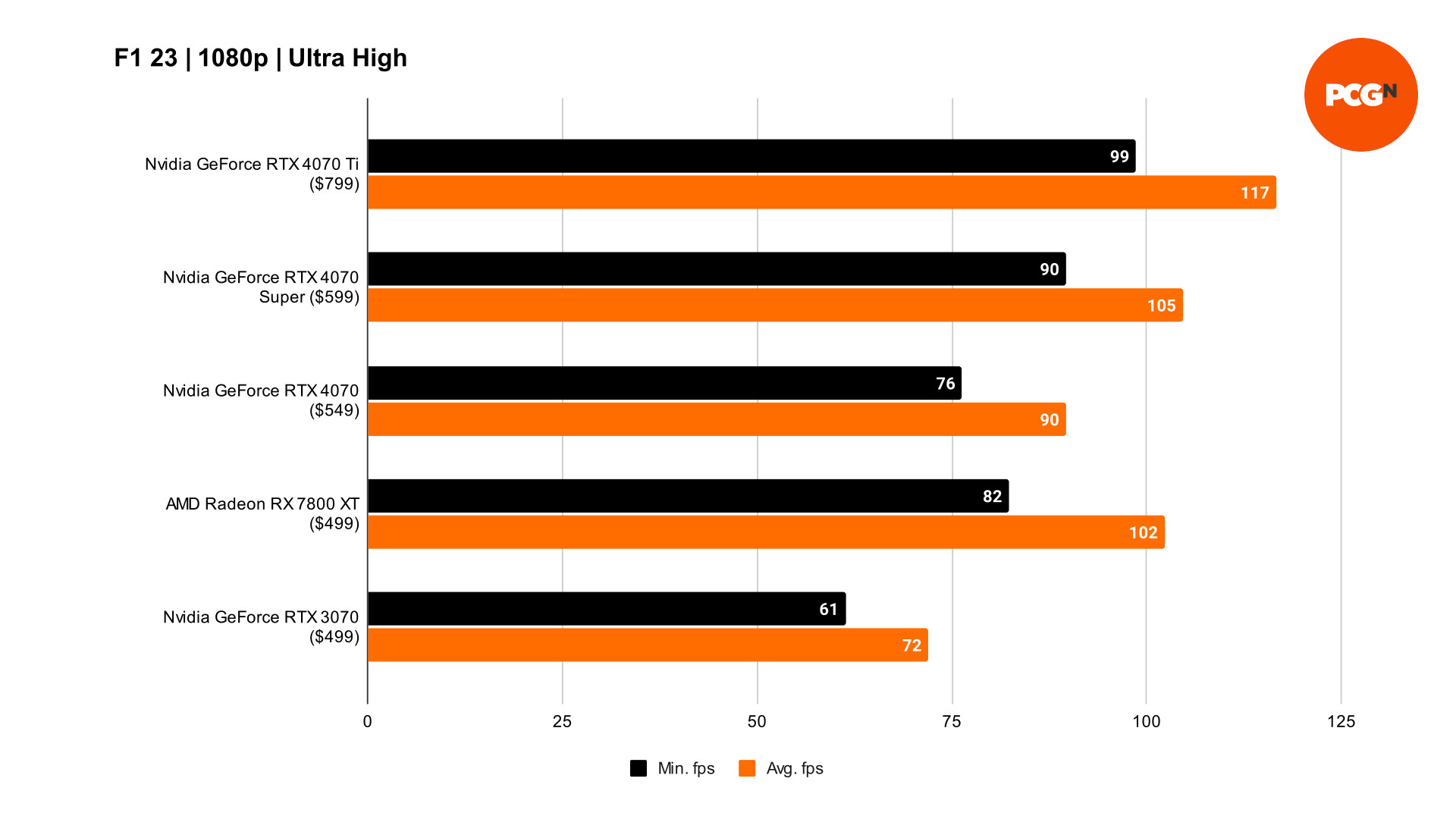


RTX 4070 Super Returnal ray tracing benchmarks
Compounding Nvidia’s lead, Returnal sees the RTX 4070 Super once again right behind the RTX 4070 Ti and leaving its more closely priced competitor and sibling firmly in the rearview mirror.


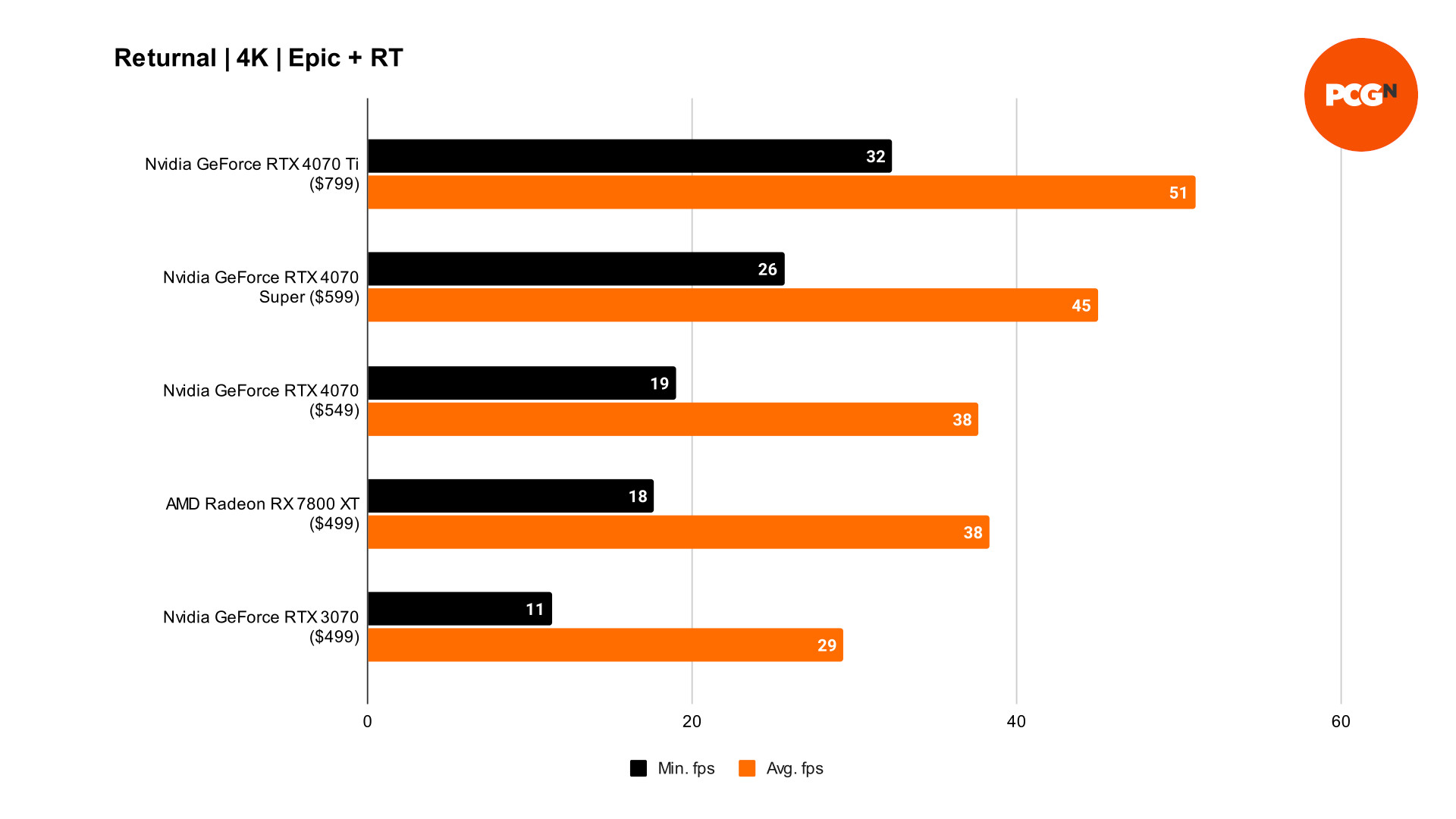
Across our suite, RTX 4070 Super ray tracing frame rates average 17% higher than those of the RTX 4070, increasing to 24% compared to the 7800 XT. In terms of generational improvements, we recorded a 60% uplift versus the GeForce RTX 3070 (discounting the Ampere GPU’s abysmal Cyberpunk 2077 4K result).
RTX 4070 Super 3DMark ray tracing benchmarks


Nvidia GeForce RTX 4070 Super rasterization
The RTX 4070 Super finds itself in an uncomfortable position when it comes to rasterized rendering. For all the improvements it makes versus the RTX 4070, the shadow of the cheaper and faster Radeon RX 7800 XT looms large.
At 1080p, the RTX 4070 Super takes the silver in all but one battle for frame rate supremacy against the RX 7800 XT. Its single victory, however, is a touch hollow, scraping a win in Returnal by a meager 2fps. Save for this result, Nvidia finds itself on the backfoot here against AMD, trailing by as much as 29fps in F1 23.
While things do not get any worse for the RTX 4070 Super at 1440p or 4K, they do not get any better either. In short, if raw rasterization is your priority then you are better served by the 7800 XT than you are by either the RTX 4070 Super or RTX 4070. This is particularly important to note if you predominantly play esports games devoid of ray tracing.
The RTX 4070 Super outperforms the RTX 4070 in our rasterized suite by 20% on average, while it loses out to the 7800 XT by 8%. This is not a terrible result but it certainly is not a great look for Nvidia when its more expensive card falls behind a cheaper alternative. We’ve published the graphs for all our rasterization benchmarks below.
RTX 4070 Super Total War: Warhammer 3 benchmarks


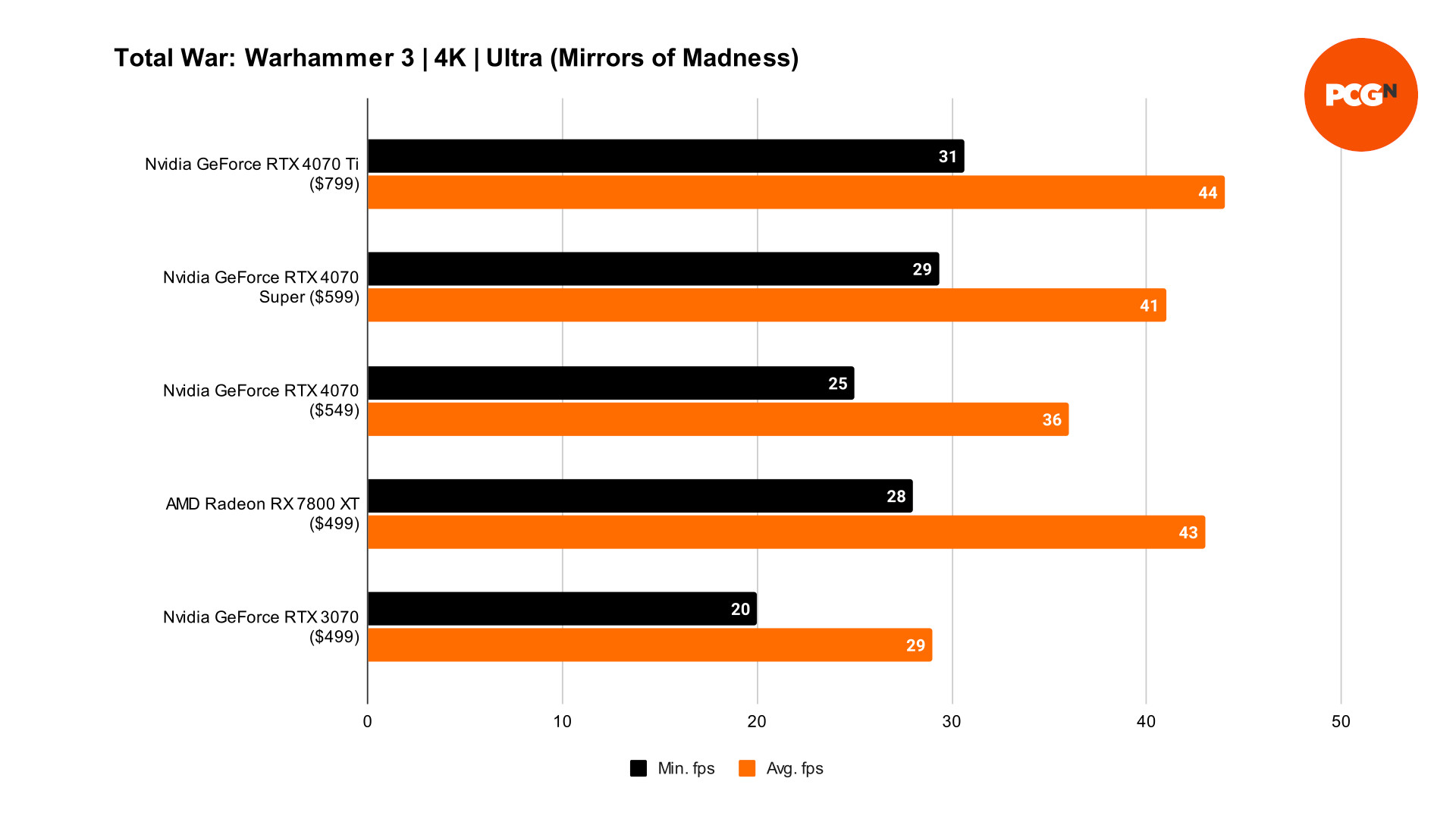
RTX 4070 Super F1 23 benchmarks



RTX 4070 Super Cyberpunk 2077 benchmarks


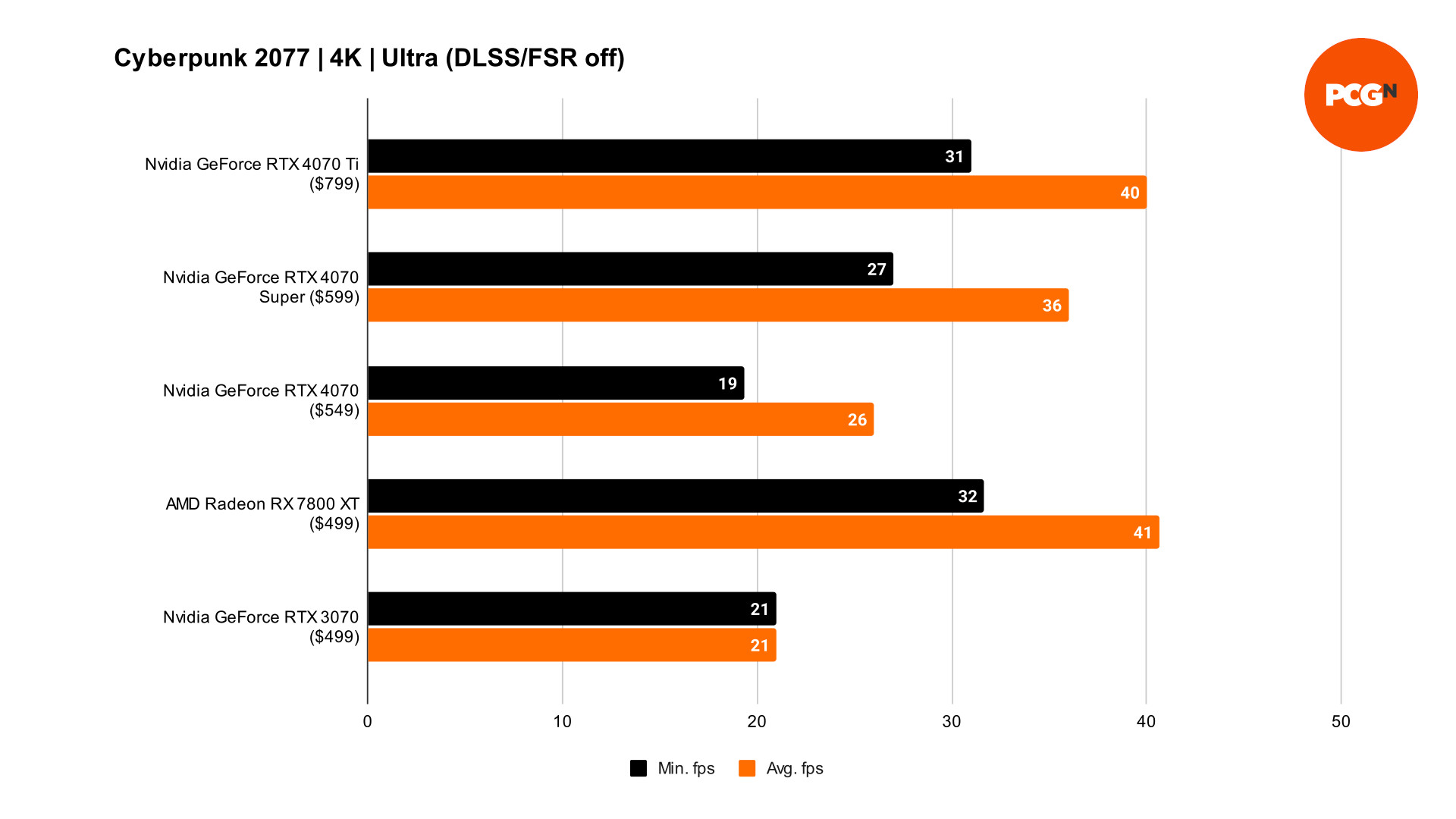
RTX 4070 Super Returnal benchmarks

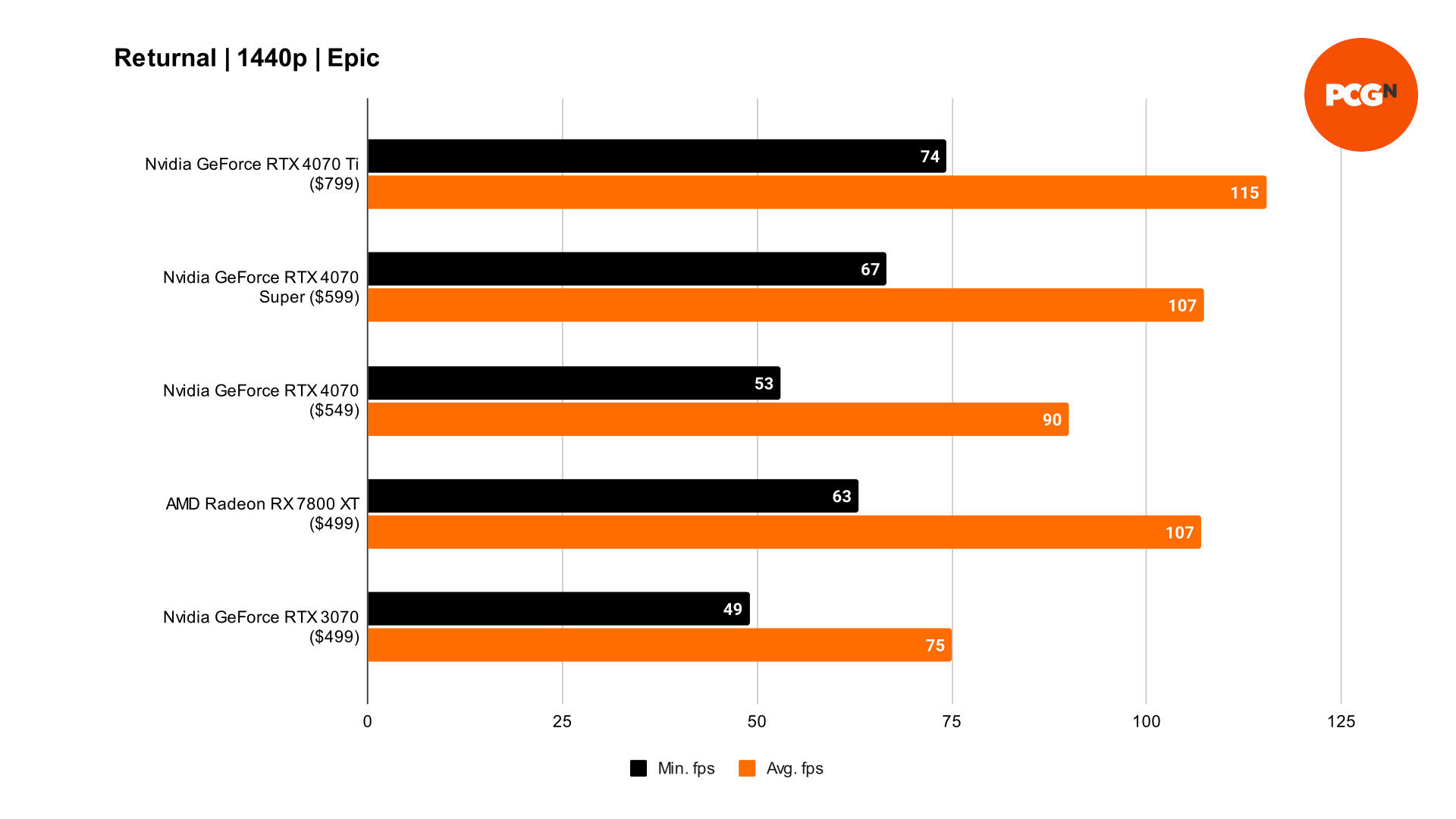

RTX 4070 Super 3DMark benchmarks

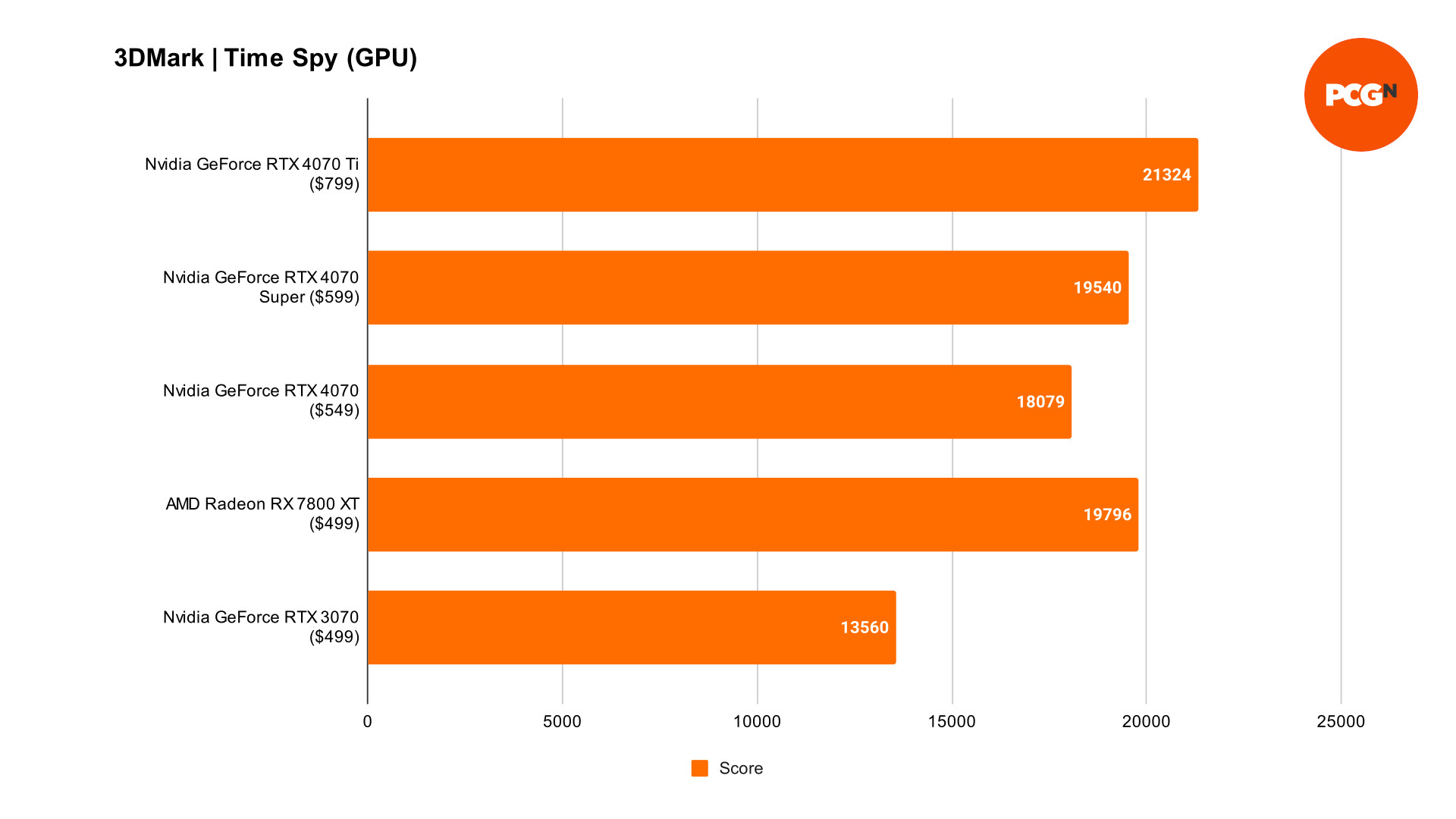
Nvidia GeForce RTX 4070 Super DLSS benchmarks
As a GeForce RTX 40-series graphics card, the RTX 4070 Super enjoys all the luxuries afforded by DLSS 3, namely Super Resolution and Frame Generation. Put into practice, these features can be used to push performance even further or salvage previously unplayable frame rates.
Enabling Super Resolution (DLSS 2) alone in Cyberpunk 2077 at 4K with RT enabled doubles the RTX 4070 Super’s frame rate to a much more palatable 41fps. It is worth noting that while the Radeon RX 7800 XT also sees a similar increase, using FSR 2, the quality of the upscaling is not nearly the same. Looking at the two side-by-side, it is clear that DLSS provides higher image quality with a sharper final render that has far less noticeable shimmering compared to FSR.
Combining Super Resolution and Frame Generation (DLSS 3) provides even more impressive results in the right circumstances. Comparing our initial benchmark of 67fps at 1080p with ray tracing enabled, we jump to 107fps using DLSS 2 before reaching the dizzying heights of 154fps with DLSS 3. Frame Generation can only do so much, however, as the previous 4K example only increased by a paltry 3fps. As such, it is important to treat the feature as an enhancer rather than a transformer.
Advantageous as DLSS 3 is, it is not the only frame generation solution on the market right now, with FSR 3 finally having arrived on the scene. However, at the time of writing, just four games include AMD’s solution compared to the dozens Nvidia has accrued. Support for both will undoubtedly increase given time, but right now GeForce graphics cards have more options to flex their features.
All this in mind, it is clear that the RTX 4070 Super offers a more robust suite of performance-enhancing technologies right now. Whether AMD can dramatically shift the landscape with the introduction of Fluid Motion Frames remains to be seen, but you should never base a purchase on potential outcomes.




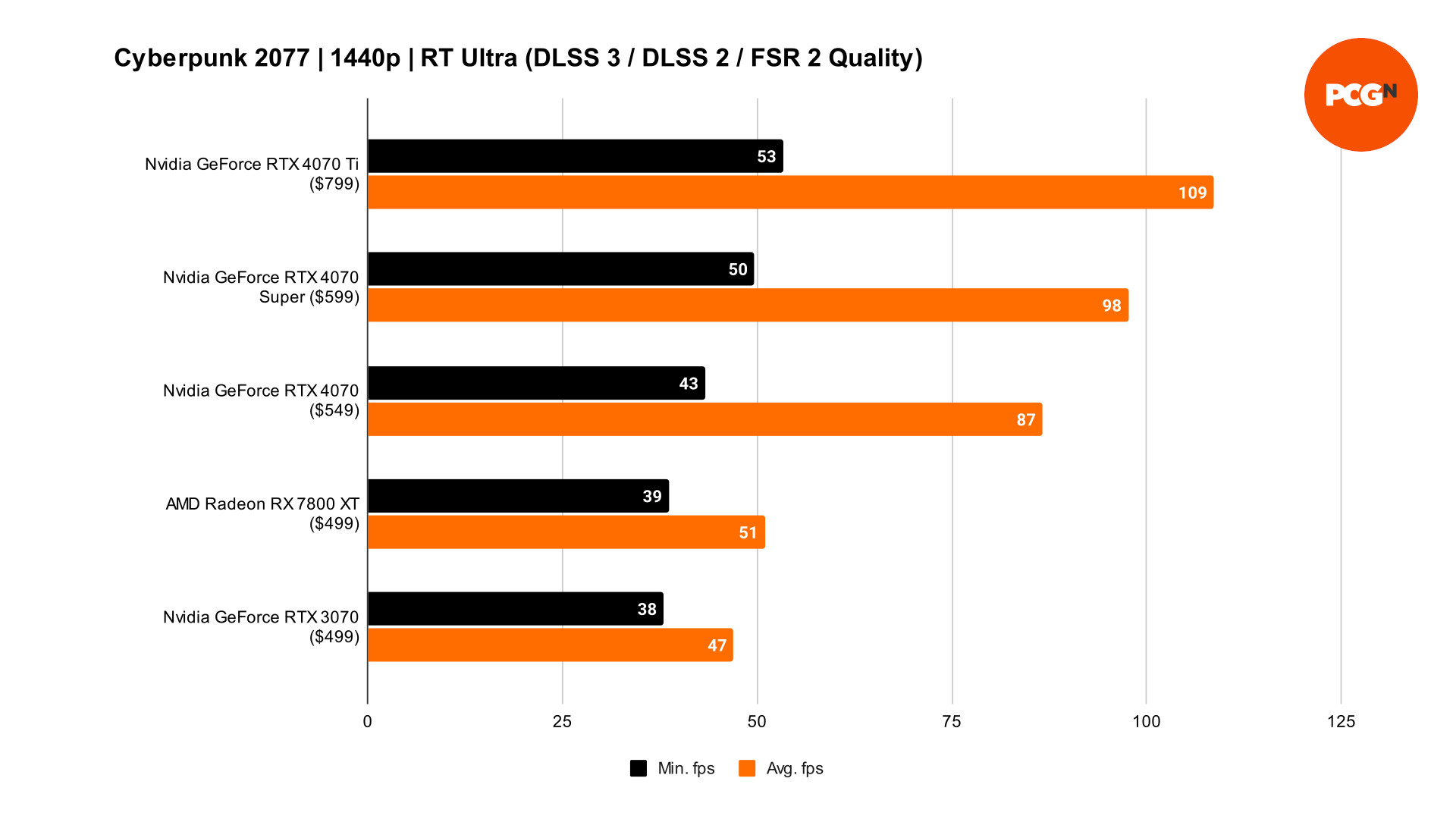
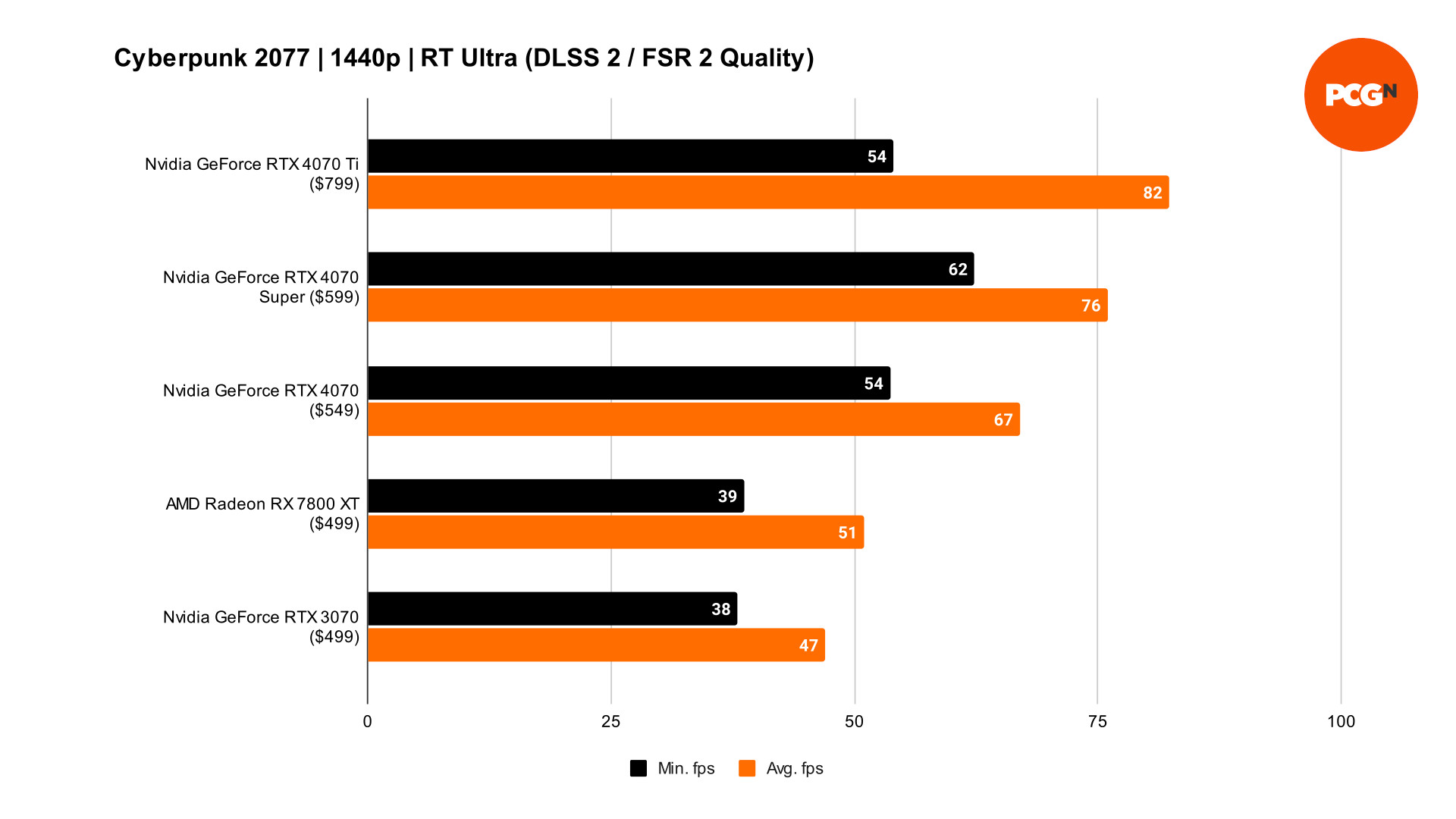
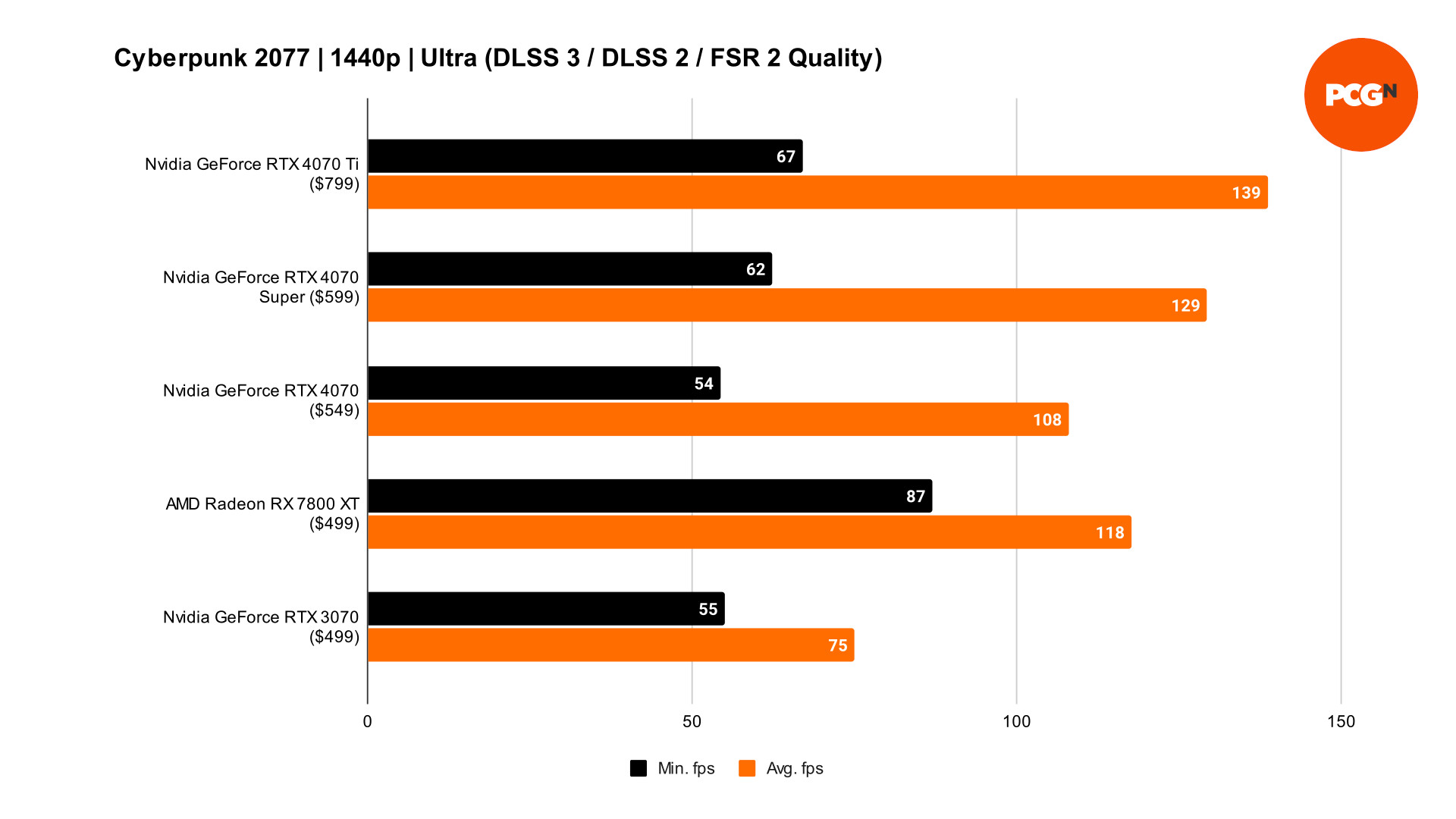



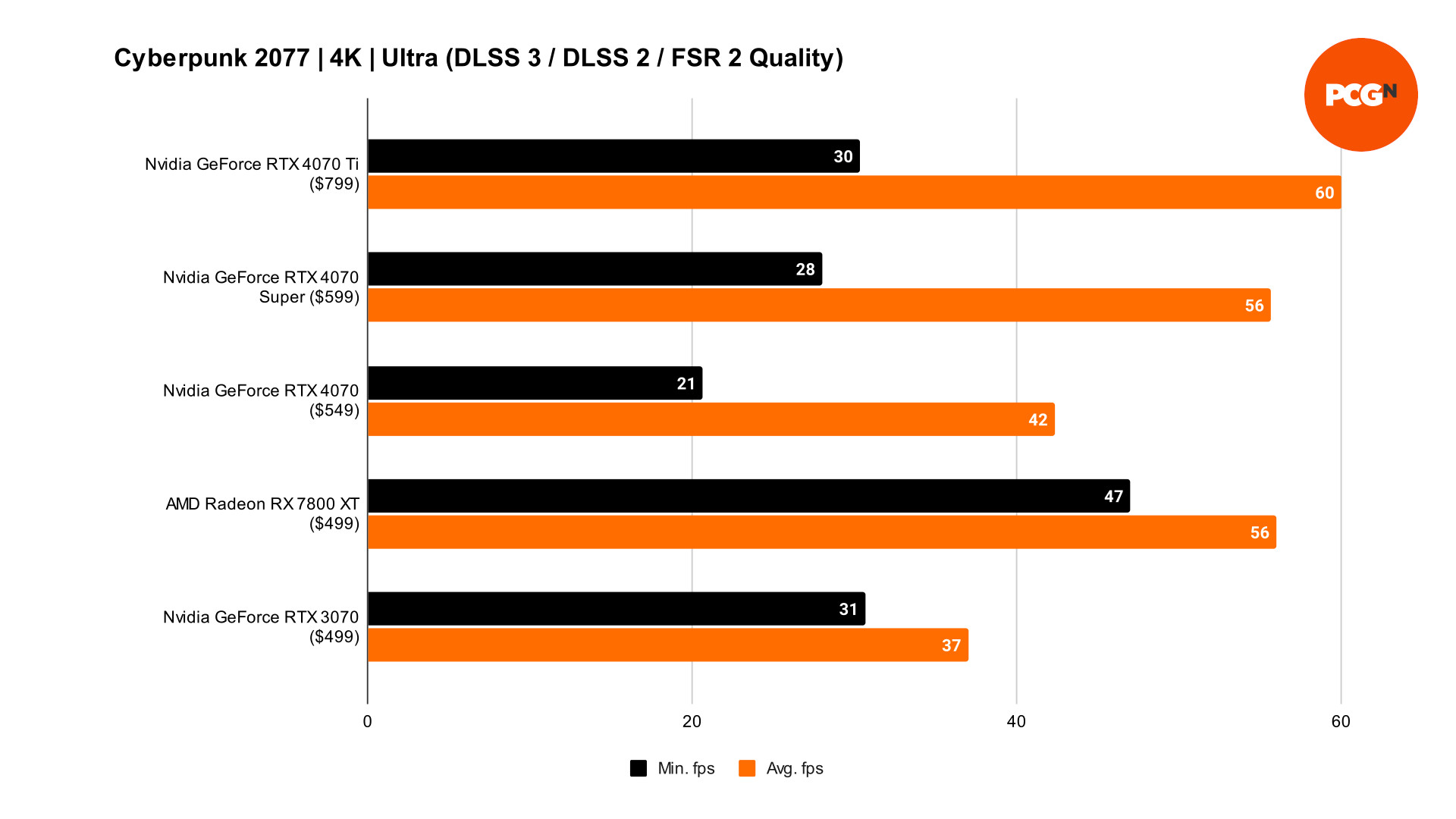

Nvidia GeForce RTX 4070 Super price
With its souped-up specs and performance, the RTX 4070 Super naturally represents better value than the RTX 4070 did at launch for the same $599 (£579) price tag, with the old card’s MSRP now being officially reduced to $549.
This $50 difference does not do much to justify the continued existence of the RTX 4070, though, as the RTX 4070 Super still amounts to a better value purchase. So much so, in fact, that we expect to soon see promotions reducing its cost down to $500, matching the price of Radeon RX 7800 XT.
Nevertheless, the RTX 4070 Super is now the most expensive mid-range graphics card on the market, and it almost completely justifies its asking price. Were it not for its minor rasterization and memory shortfalls, it would be a no brainer. It’s great to finally see multiple viable options in the $449-599 price range. Now, if AMD can crank out a Radeon RX 7900 non-XT of sorts, we should be able to plug the gaping $700 gap nicely.
Is the Nvidia GeForce RTX 4070 Super worth it?
The RTX 4070 Super does exactly what its name implies, taking everything great about the original RTX 4070 and making it even better. It still has the same flaws, but they’re somewhat easier to stomach now given the increased performance and value presented in this new package.
Like the more expensive GeForce RTX 40-series models, the RTX 4070 Super silicon lays an excellent foundation on which DLSS technologies can build to achieve truly exceptional performance. Its 12GB VRAM capacity remains a sore spot, though, as I’m sure this GPU has plenty more to give were it afforded the bandwidth, especially for future, more demanding games.
In conclusion, the RTX 4070 Super is easily the best graphics card for most folks if your budget can stretch to it. If not, both the RTX 4070 and Radeon RX 7800 XT are solid alternatives too.
Nvidia GeForce RTX 4070 Super alternatives
If the RTX 4070 Super is not for you, here are a few alternative graphics cards to consider instead:
Nvidia GeForce RTX 4070
The RTX 4070 is not being discontinued and will instead carry on as a $550 option. While it isn’t as quick as the GeForce RTX 4070 Super, it still enjoys the same level of DLSS 3 support and is a stronger ray tracing graphics card than any cheaper option from either Nvidia or AMD.
Read our Nvidia GeForce RTX 4070 review to learn more.
AMD Radeon RX 7800 XT
The RX 7800 XT is $100 cheaper than the RTX 4070 Super and can actually outperform the more expensive graphics card in some instances. Its strengths lie primarily outside of the ray tracing realm, and its 16GB of VRAM and solid shader power give it headroom to push pixels at resolutions up to 4K.
Read our AMD Radeon RX 7800 XT review to learn more.



